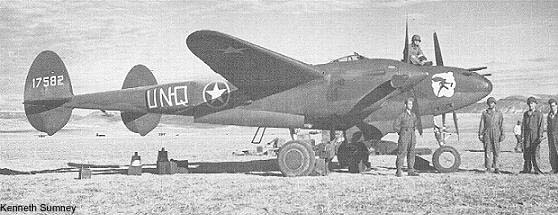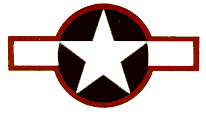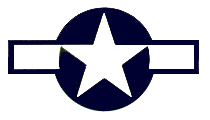
Try Amazon Audible Premium Plus and Get Up to Two Free Audiobooks


Throughout the summer of 1942, P-38 fighters had been arriving in Britain, having been ferried across the North Atlantic. It wasn't until September that the Lightnings began to fly operational combat missions over the continent. Luftwaffe opposition was virtually non-existent. The Germans elected to ignore the P-38s. The 27th, 71st and 94th Fighter Squadrons did not encounter Luftwaffe fighters until late October. Only one P-38 was lost on operations, likely to navigation difficulties and not enemy action. In September, both operational Lightning groups had quietly been transferred out of the 8th Air force, into the 12th AF in preparation for deployment in operation TORCH, the invasion of North Africa. On November 10th, the French Vichy forces resisting the Allied invasion surrendered at Oran and the P-38s began their ferry flights from England.
The majority of P-38s utilized in North Africa were P-38F types. Some P-38Gs did arrive and saw service. It is worth noting that the G model was a considerable improvement over the F. Nonetheless, the P-38F was the more common variant over Africa. Indeed, it was the P-38F that overpowered the Luftwaffe above the desert. Initially, however, the Lightnings flew at a considerable numerical disadvantage to their German and Italian counterparts. Every conceivable type of mission was undertaken, with the exception of night interception. P-38s bombed and strafed German infantry, interdicted Luftwaffe transport aircraft, escorted light and medium bombers and were frequently called on to escort heavy bombers. In each and every role, the P-38F proved to be not only up to the task, but equal or superior to any enemy aircraft encountered. Suffering from the limitations of relatively small numbers, and being shackled to "close escort" tactics, the P-38 still gave better than it received.
By January 1943, the P-38 had established itself as "the" fighter aircraft in North Africa and the Mediterranean Theater of Operations. The Afrika Korps continued to take a pounding by the Lightnings. German truck convoys were butchered by P-38s roving the desert. Combined with AAF P-40s and Airacobras, the RAF continued their determined air campaign against the German effort. By late winter, the Luftwaffe was flying as many as 100 transport sorties across the Straits of Sicily to re-supply the exhausted Afrika Korps, who had been squeezed into Tunisia by U.S. forces from the west and the British 8th Army from the east and south. Generally flying at altitudes below 100 feet, these transports were usually escorted by Bf-109 and Fw-190 fighters. Allied fighters were deployed to intercept these transports, the North African Air Force P-38s being cut loose to hunt down the Luftwaffe.
On April 5th, twenty six P-38s intercepted a huge formation of German transports and their escort. 16 of the German aircraft went down, including two of the escorts. A pair of P-38s were lost, with one pilot missing in action. Elsewhere, P-38s accounted for another 15 German fighters. Combined efforts of NAAF fighters and bombers destroyed up to 200 Luftwaffe aircraft on April 5th,with many destroyed on their airfields. Just 5 days later,on April 10th, the P-38s destroyed another twenty German transports and 8 escorting German and Italian fighters. Later that afternoon, B-25 Mitchell medium bombers and their escort splashed 21 more transports and four of the escorting fighters. Despite these serious losses, the Luftwaffe continued to fly these aerial "convoys". On April 11th , the Lightnings located and destroyed another twenty six Ju-52 transports and 5 Bf-109 fighters did not return to their airfields that evening. The Luftwaffe was being bled white. Finally, the German re-supply effort came to a halt when an entire convoy of the massive Me-323 Gigant six engine transports was shot down by a combined force of Spitfires and South African P-40 Kittyhawks.
The Allies had achieved air superiority by April 22nd. There remained some Luftwaffe aircraft in Tunisia, however, they were soon destroyed or evacuated to Sicily. On May 13th, 1943, the last of the Deutsches Afrika Korps surrendered to the Allies, having fired off all their remaining ammunition and destroying any usable equipment. About 240,000 Germans and Italians went into captivity. The focus of all now turned to Sicily. The Germans understood that this would be the next target of an Allied invasion. The question was, what could the Luftwaffe do to defend the island?


In the succeeding four weeks, the fighter defenses established on Sicily were quickly decimated, both in the air and on the ground by around the clock bombing and the relentless fighter sweeps. Operation HUSKY was launched on July 10th, 1943. The Luftwaffe was powerless to intervene. Just 37 days later, the last of the German Army was evacuated to the Italian mainland. The Luftwaffe had long since withdrawn its aircraft from the island. Those badly battered German fighter units never had a chance. Johannes Steinhoff, in his remarkable book "Messerschmitts Over Sicily", writes that the air defense of the island was "hopeless". Far too few aircraft, virtually no effective early warning system, thoroughly worn out maintenance personnel and pilots both physically and mentally exhausted, the Luftwaffe never had a chance. Steinhoff had gone directly to Galland pleading for reinforcements. In a flash of anger, Steinhoff told the Commander of the Fighter Arm that the Luftwaffe no longer held the qualitative nor the quantitative advantage. The fact that American P-38s could and would turn up anywhere at any time was very troubling. Moreover, the clear superiority of the Lightning, in both speed and maneuverability, was especially disconcerting. Steinhoff expressed his concern that the Luftwaffe High Command did not understand the type of air war that the Reich now found itself engaged in. Galland understood the problems, but emphasized that there was little that could be done in the short term. Sicily was as good as lost weeks before the first Allied soldier waded ashore.
The Luftwaffe offered a much stiffer air defense over Sardinia. A huge brawl developed over the island on July 30th. AAF P-40s tangled with a large concentration of Bf-109s flown by young, inexperienced pilots. The P-40s were credited with the destruction of 21 of the Messerschmitts for the loss of only one of their own. Post war analysis seems to indicate that only five or six 109s fell to the Americans. Although, many others were damaged and several were completely written off. Repeated sweeps over Sardinia by large formations of P-38s ground down the Luftwaffe, leaving the island virtually defenseless by the end of August. Sardinia was captured shortly after Italy threw in the towel. U.S. forces landed unopposed on September 14th, 1943.

Luftwaffe airfields received a severe pasting time and time again. On August 25th, a force said to exceed 140 P-38 fighters, laid waste to the Foggia airfield complex. Unwilling to expose their aircraft and pilots to the free ranging Lightnings, the Luftwaffe found itself on the ground at Foggia when 136 Flying Fortresses with a large P-38 escort blasted the Foggia complex into ruin. As many as 47 aircraft were destroyed on the ground with another 13 badly damaged. The battering of the Luftwaffe in southern Italy went a long way in aiding the American landings at Salerno on September 9th, 1943. The P-38 was critical to the air defense of the invasion as it was the only land based fighter which had the endurance to remain over the battlefield for any duration of time. The Germans moved some 100 aircraft south and soon threw them into the fight, attacking the invasion forces on the 11th and 12th of September. P-38s repeatedly broke up German attacks, and along with Royal Navy Seafires, destroyed some twenty of the attackers. Losses to the Allies were light, with exhausted pilots losing far more aircraft to landing accidents than to enemy action. As the Allies moved inland, airfields were established on the mainland and pilot fatigue became far less of a problem. Moreover, as the 12th and 15th Air Forces gained in strength and acquired newer aircraft, such as the P-38H and J, as well as the P-47, the Luftwaffe lost any hope of regaining air superiority over Italy.
The P-38 would go on to be the dominant fighter aircraft in the MTO until its gradual replacement by the P-51 beginning in mid 1944. The Lightnings were not replaced because the Mustang was superior. The replacement was one based upon economy. The Mustang was far cheaper to manufacture, and with only a single engine, was far easier to maintain as well. In terms of performance, The P-51 exceeded the Lightning in only one area: Maximum speed, and only between 22,000 and 27,000 feet. At nearly every other altitude the P-38 had the edge. Especially later variants with revised intercoolers. The Lightning, in particular, the P-38L (the largest production run model) was equal or even superior in every other area of performance. It is not unusual to find that a significant number of pilots who flew both in combat, would choose the P-38 over the Mustang as a dogfighter. Der gabelschwanz teufel, indeed.

